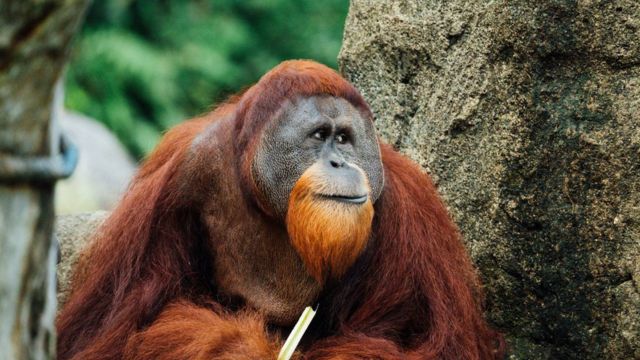Wild Wisdom! Orangutan’s Use Of Medicinal Plant For Wound Care Confirmed By Scientists
WASHINGTON – Scientists announced on Thursday that an orangutan appeared to treat a wound with medication from a tropical plant, the most recent instance of how some animals try to cure themselves using treatments found in the wild.
Researchers watched as Rakus picked and chewed on leaves from a medical plant that is used as an anti-inflammatory and pain reliever throughout Southeast Asia.
Then, the adult male orangutan applied the plant juices with his fingers to a wound on his right cheek. According to a new study published in Scientific Reports, he then applied pressure using the chewed plant to the open incision, thus using it as a makeshift bandage.
Several species of great apes have been shown in earlier studies to heal themselves by searching for medicinal plants in forests, but no animal has yet been observed to do this for itself.
Co-author Isabelle Laumer, a biologist at the Max Planck Institute of Animal Behavior in Konstanz, Germany, said, “This is the first time that we have observed a wild animal applying a quite potent medicinal plant directly to a wound.”

The fascinating behavior of the orangutan was seen in 2022 by Ulil Azhari, a field researcher at the Suaq Project in Medan, Indonesia, and co-author. Images demonstrate how the animal’s wound healed properly in less than a month.
Although they have been studying orangutans in Gunung Leuser National Park, Indonesia, since 1994, scientists had not before documented this behavior.
SEE MORE – Is This Real Case? Graham Hands Over Phone To FBI Over Suspected Hacking Concerns
Not engaged in the study, scientist Jacobus de Roode of Emory University stated, “It’s a single observation.” But frequently, we begin our understanding of novel actions with a single observation.
De Roode stated that the orangutan put the herb solely on the wound and not on any other part of its body, suggesting that it was most likely self-medication.
According to co-author Caroline Schuppli of Max Planck, it’s likely that Rakus picked up the skill from other orangutans who don’t live in the park and aren’t subjected to the constant observation of scientists.
Rakus was raised outside of the study area after leaving his birthplace. It is thought by researchers that the orangutan was injured in a struggle with another species. Rakus may have already treated additional injuries, although this is unknown.
Previous observations by scientists indicate that other monkeys self-treat with plants.
The therapeutic plant’s juices were applied to the bodies of Bornean orangutans, maybe as a way to ward off parasites or ease physical discomfort.
It has been found that chimpanzees in various regions ease their upset stomachs by chewing on the bitter-tasting plant shoots. To get rid of stomach parasites, gorillas, chimpanzees, and bonobos ingest certain tough leaves whole.
What might this behavior reveal about the early evolution of medicine if it is present in some of our closest surviving relatives? stated Tara Stoinski, who was not involved in the study but is the president and chief scientific officer of the charity Dian Fossey Gorilla Fund.











